VR Arcade at Denver Film Fest Brings Futuristic Fun to the Masses
Denver correspondent Danielle Look recaps the 11 different experiences
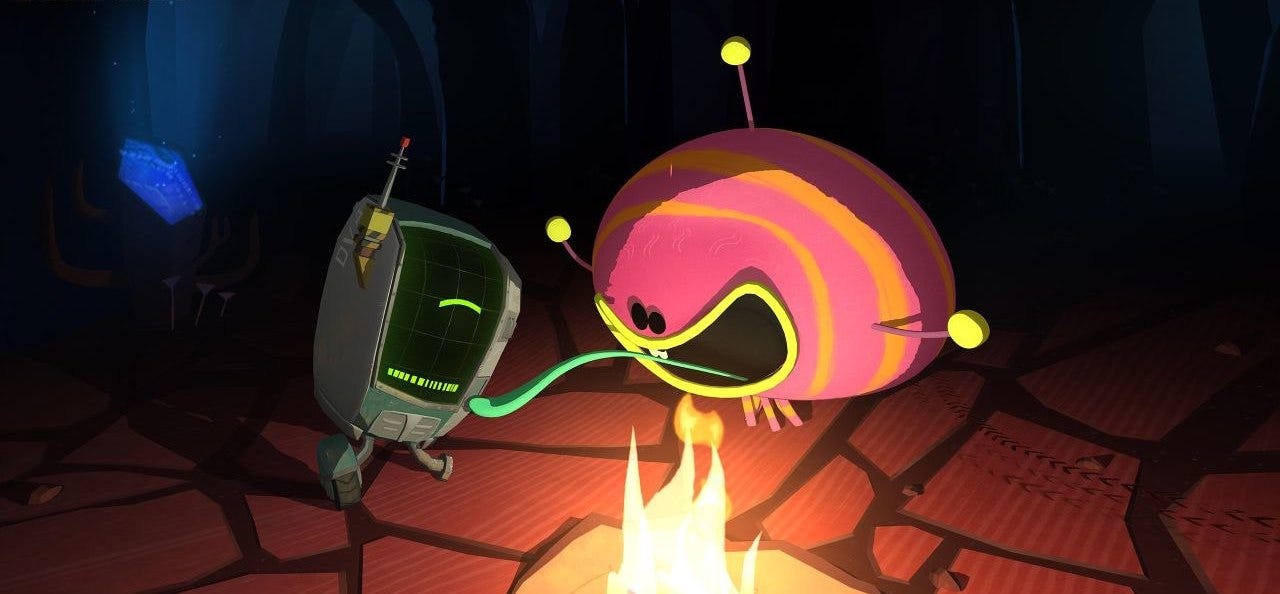

Since their first VR offerings in 2016, Denver Film Festival continues to build and expand upon each year’s success. This year, the VR Arcade offered eight different shorts in addition to three separate ticketed experiences.
Created with accessibility in mind, Denver Film Fest nailed the layout and design of the lounge. Low lighting and high energy electronic music created a relaxed, but also club-like, atmosphere. A giant LED wall next to the bar displayed curious projections by Supernova, a digital animation streaming app. Comfortable chairs and couches were everywhere throughout the lounge, and ample cocktail tables were available for congregating. It was a space designed to do more than put on a headset and rotate through stations. It was a destination — a place to hang out, to play and to share novel experiences with friends. All open to the public for hours at a time — sometimes free, sometimes ticketed — inside the McNichols Building at Civic Center Park in the heart of downtown Denver.
Upon entering the lounge, patrons were directed to a desk where they could digitally sign up for the VR experiences they wanted to see. Much like the same software used to manage restaurant reservations, patrons were notified via text when their session was about to begin. Between VR experiences, they were invited to sip on complimentary Novo nitro coffee and KIND bars, or pick up an adult beverage from the bar.
Ticketed Experiences
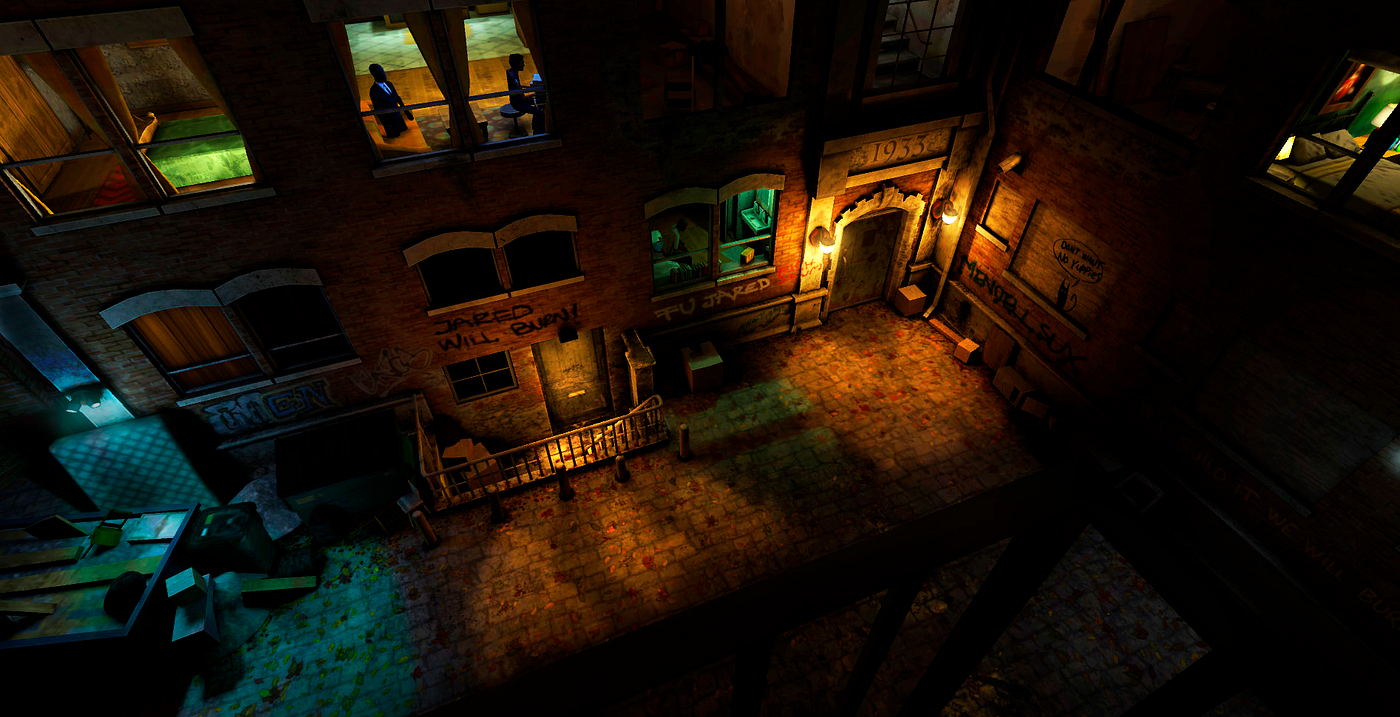
Fire Escape ($22 non-member ticket, 45 minutes)
A completely different experience than the 5–20 minute vignettes found in the free lounge, Fire Escape is the future of VR entertainment. Presented across three different “episodes,” this 45-minute experience looks and feels exactly as it’s prescribed: you’re sitting on your third-story fire escape landing in the middle of NYC, watching drama unfold in the building across the alley.
Your source of interaction with the experience is the clicker in your hand, which is displayed in-world as your mobile phone. Sometimes you actually get phone calls on it, other times you use it to select which rooms you’d like to zoom in on and listen in to. Much like a live immersive performance, events are unfolding simultaneously, and it’s your choice where to spend your time. This is a powerful component of the game, as it affects your perception and understanding of what exactly is going on. If you miss a crucial conversation or interaction because you were watching an old woman cry over her dead pet bird, you might not have the complete picture.
Over the course of the 45 minutes, you really get to know the personalities of the building tenants and their respective homes. But what’s just as impressive as the character and plot development is the pure beauty of the fully immersive setting. Taking a break from the action unfolding in front of me, I look to my far left and notice my surroundings — a half-eaten slice of pizza sitting on a plate outside my window sill. On the ground, I see and hear cars roll by bumping music, or a parent crossing the street hand-in-hand with child. In the second episode, the cops have arrived, and they’re blocking the building’s entrance with their vehicles, complete with flashing red and blue lights. In the distance, on both my left and my right, I see the New York City skyline and the blood moon rising.
The game also plays to our voyeuristic tendencies. It’s fun to hear secrets, or to watch someone when they don’t know they’re being observed. Here, you get to do that in a completely safe (and legal!) way, but with Inspector Gadget-like audio and visual zooming abilities. I think what makes this such a home run is the perfect blend of familiarity (which allows us to anchor the experience to something we know and understand from the real world) and magic (which makes this more than just a simulated version of our everyday existence).
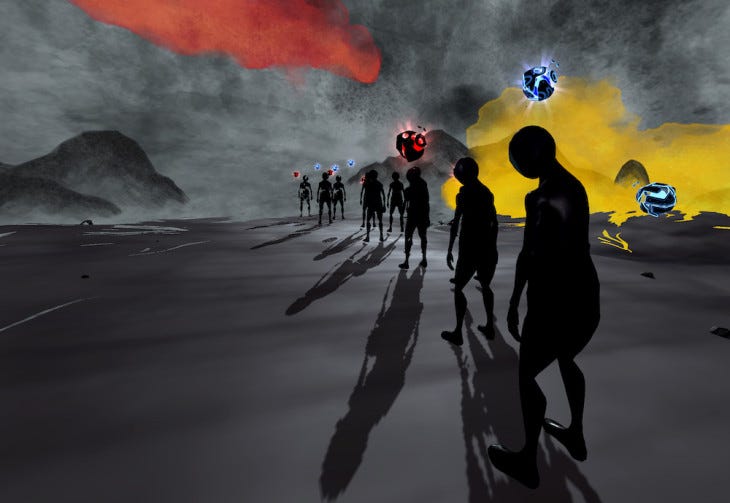
The Key ($22 non-member ticket, 30 minutes)
This 30 minute experience begins by putting participants in a small room with a live actor. The walls are lined with large portraits of the world I’ll soon be entering. I’m given a sound device that wraps around the back half of my neck and rests on my shoulders, effectively replacing typical headphones. Standing inside the dimly lit, bare room, the live actor never speaks to me directly, but I hear her thoughts through the audio device. We make intimate eye contact for several minutes before she helps me don the VR headset and controllers.
The content that follows is mysterious and nebulous. The world I’m transported to is not at all like Earth. It feels totally foreign, and even a bit unsafe. I have precious objects taken from me, I meet a towering monster, and I stand in an endless line with hundreds of the enigmatic creatures of this world. The game allows for a bit of interaction (holding and pulling the precious objects, for example) but it’s largely a passive experience from a gaming perspective. It’s a story to be told, not a game to be played.
What I found most interesting and unique was the standing, full-room experience that lets the participant move about the space. With the wireless headset and audio device, the untethered player is exposed to a new level of immersion. Even though I didn’t really understand what was happening to me in the story, the wireless tech liberated me to roam and explore in-world.
After meeting this mysterious person and exploring her foreign world, I’m suddenly transported to a real life scenario here on earth: a modest apartment in shambles amid a dilapidated village. The scene is so authentic, that I actually step forward and lean over so I can peer out of windows to evaluate my new surroundings. My guide suddenly remembers what this is all about: I’m standing in her home, and she is a refugee.
When the video comes to an end and the headset is removed, the actor swings open the large paintings on the wall to reveal photos of actual refugees alongside facts and figures about this devastating reality of today’s world. I’m suddenly swimming in cognitive dissonance. With no hint whatsoever until this very moment that The Key would end in such serious subject matter, I feel mislead. I never saw this coming, and it conflicts with the theory I was developing in my own mind. The leap from the VR experience to today’s refugee situation is a big one, and its exploration felt shallow once we got there. The tech and VR is impressive, but the story and content is not at all engaging to me.
More strangely, as I exit the room, I’m escorted to a couch meant to be a place to sit and gather myself in the wake of what I’ve just experienced. This, and the overt efforts to protect the reveal at the end, feel dramatic and unnecessary.
The tech was impressive, the mixed media concept was fun, and the design of the alternate world was beautiful. What’s missing is the crucial context needed to draw in the right audience and accurately set up their expectations.
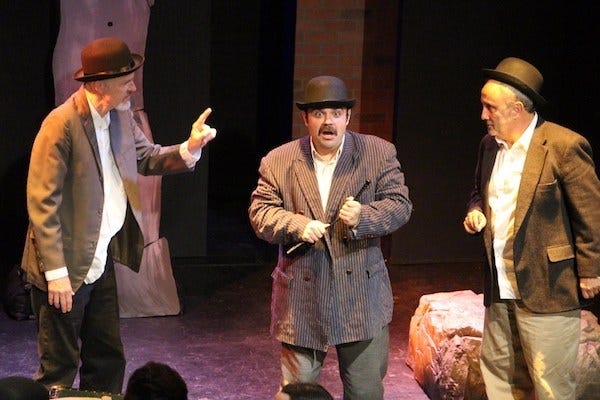
Escape From Godot
They said you need not be familiar with the source material to enjoy this production, but I would argue that knowing the story of the short 1950’s play would enhance one’s experience inside this zany theater/escape room hybrid.
In Escape From Godot (it’s pronounced “god-oh”), the scenario is quite similar to the original Waiting for Godot: two fellows are waiting for Mr. Godot to arrive (we don’t know why) and some mildly interesting things happen to them as they wait.
Except here, in Escape from Godot, we’re treated as stage managers for the production, not passive viewers of the play. And when the characters get stuck on loop at certain points throughout the show, it’s our job to complete the puzzle that allows them to move on. This struck me as a creative way to see the source material through a different lens, and incorporate interactive elements into the play.
This 60-minute experience is far from being a mind-blowing escape room, but it’s not really intended to be a typical escape room experience, either. Instead of clues or props progressing the story, actors are present to give the narrative more dimension.
The puzzles are not immensely difficult or especially novel, nor do they contain any fancy tech or effects; they are instead designed as a structured way to directly engage with the content of the play. While the puzzles were sometimes better suited for two or three participants, instead of involving the entire group of eight, I found it to be an interesting way to remix an otherwise boring story.
To top it all off, the actors portraying the play’s five characters were ruthlessly devoted to their parts and an essential element of the experience. They were authentic, believable and utterly hilarious.
Non-Ticketed Experiences
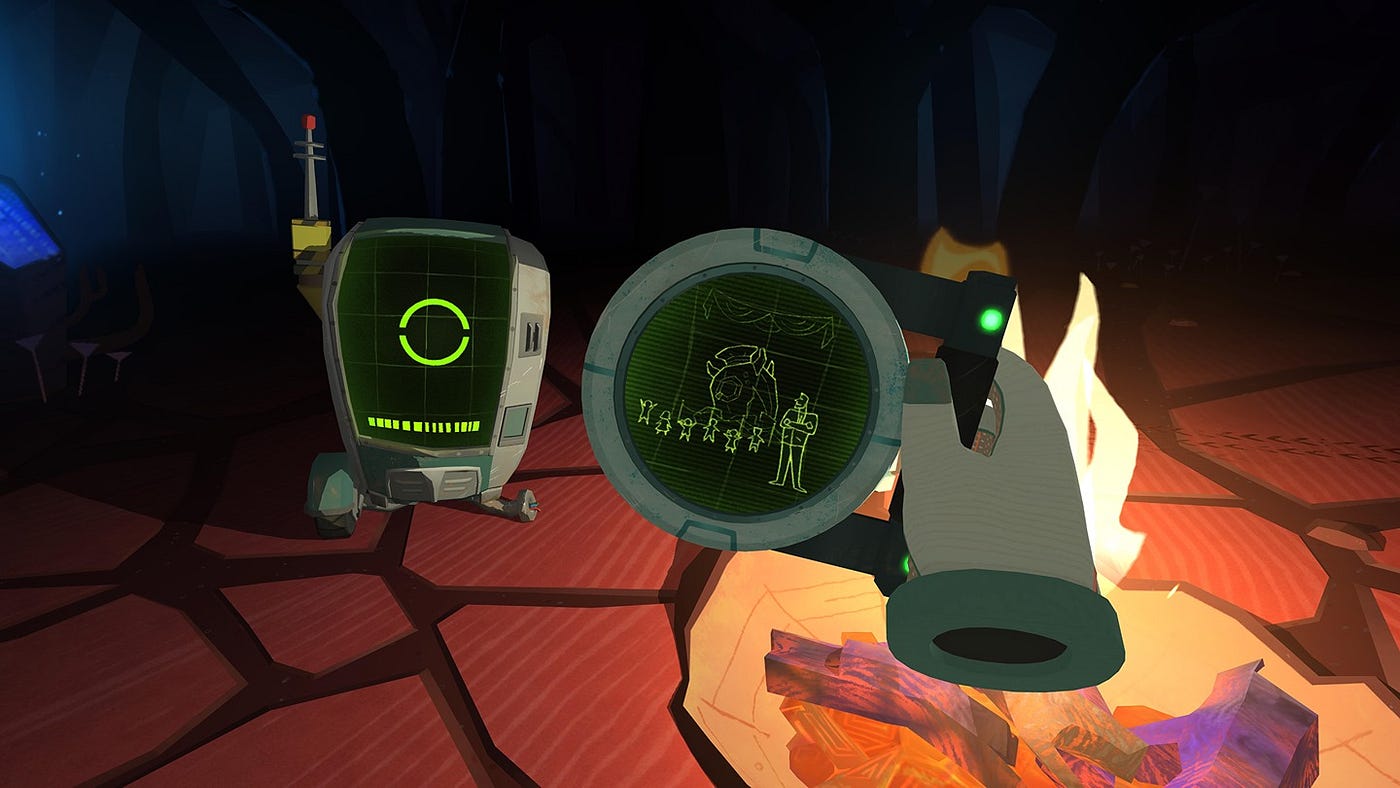
Bonfire
Nice job: You’ve crashed your spaceship into an alien jungle. Your instincts, nourishment cylinders, and wary robot sidekick are all you’ve got to rely on for survival. Or so you think.
The best experience that the free VR Lounge had to offer, Bonfire has the perfect mix of meaningful interactivity, an entertaining storyline, and high quality graphics. This 10-minute journey hits the VR sweet spot by taking you somewhere you’re familiar with, but altering it enough to make it new and interesting. With your wrecked spaceship in the shadows behind you, a bonfire burns in front of you in the middle of the woods… except you’re on another planet, and there’s definitely something lurking in the weird-looking trees all around you.
Bonfire exceeded all other VR experiences in the lounge by putting the viewer at the center of it all. Inside this remarkably life-like cartoon world, my robot companion looks right at me when she talks. When the adorable alien shows up, he responds to the objects I toss at him. Most notably, at the end, I get to make a crucial decision that brings closure to the story in a simple, yet immensely satisfying way.
The story makes sense, feels natural, and isn’t overly complicated — which is more than I can say for most of the other experiences I played. I got to press buttons in a spaceship cockpit, inspect my foreign surroundings through the lense of a special gadget, and play fetch with an alien we end up calling Pork-bun. It’s cute. It’s fun. It’s magical. And it’s not too long, but also doesn’t feel rushed.
In other words, it’s perfect.
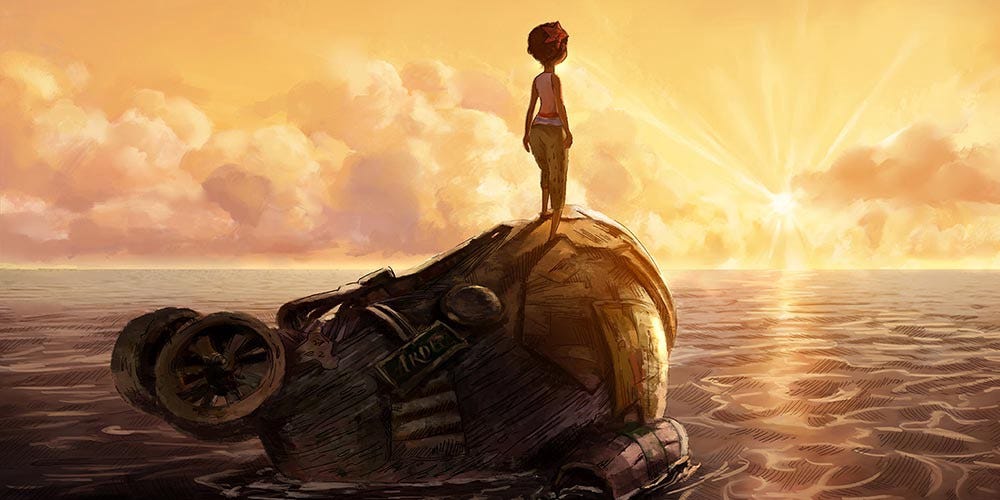
Arden’s Wake
In a post-apocalyptic world, a young woman lives with her father in a lighthouse at the edge of an endless sea. When he disappears, she must embark on a thrilling journey of self-discovery.
This 20-minute animated short takes place both above and below the sea, which is part of what makes it so fun. The story line tries to cover too much ground in too little time, so it requires a bit of focus and attention to keep up with the narrative. But if you allow the story to take a backseat and really let yourself settle into the effects, Arden’s Wake makes for a mighty fun deep sea adventure.
Get Danielle Riha’s stories in your inbox
Join Medium for free to get updates from this writer.
SubscribeSubscribe
While above the water, I really enjoyed floating around in the family’s home like a doll in a dollhouse, but the highlight of the experience came when we entered the dark depths of the sea. Unlike Bonfire, Arden’s Wake opted out of a first-person view and instead suspends the viewer right in front of the main character as she moves about the world. You’re with her every step of the way, but you also have the benefit of a wider view of her surroundings. So when a giant sea creature starts circling her, you realize what’s happening long before she does.
Arden’s Wake attempts to be more than just a simulated world to play in. It takes the viewer along for some adventure, but also for Arden’s personal transformation, which is beautifully portrayed and executed in the VR world. It’s a lot like a condensed Pixar movie, right down to the inspirational message you’re supposed to extract at the end. The effects blew my mind, and the story was pretty good, too.
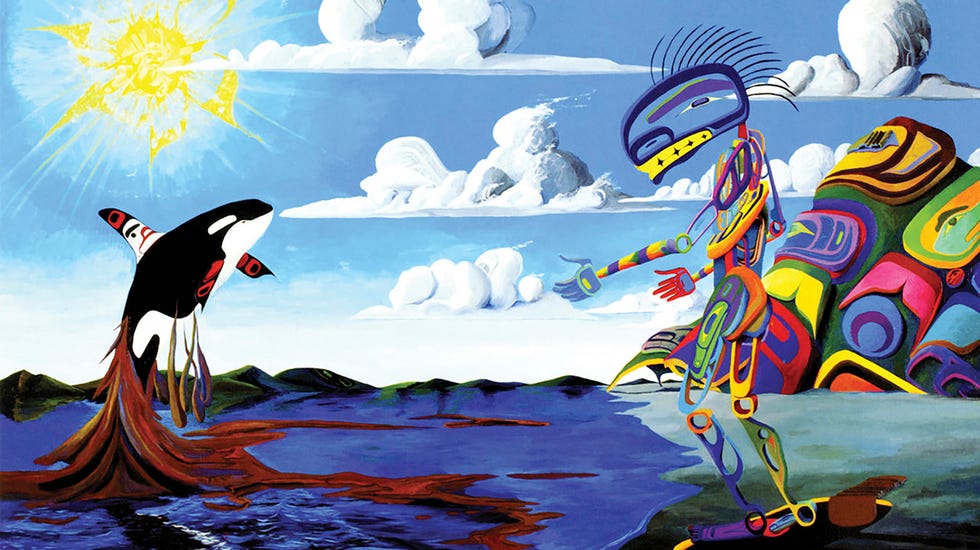
Unceded Territories
This provocative VR experience, based on First Nations artist Lawrence Paul Yuxweluptun’s iconic work, is designed to engage viewers on issues of colonialism, climate change, and indigenous civil rights in an interactive landscape.
Unceded Territories was the best use of the VR medium to explore a serious subject matter that I saw at the festival. That’s because it completely re-created the environment in which the story was told, instead of trying to “fit” the viewer into a VR version of a real place in the real world.
The film’s directors could have easily put the viewer in the middle of an actual Indian reservation and tried to show how industrialization is tearing it down. Instead, they created an expressionistic alternate world full of vivid colors and psychedelic shapes to represent the natural beauty of the wild. Then, they gave me the symbolic tools of industrialization to wipe away all the color and kill off the natural beasts, encouraging the viewer to think about their own role in climate change.
Topped off with a thrilling soundtrack by A Tribe Called Red, this VR short was also among my favorites.
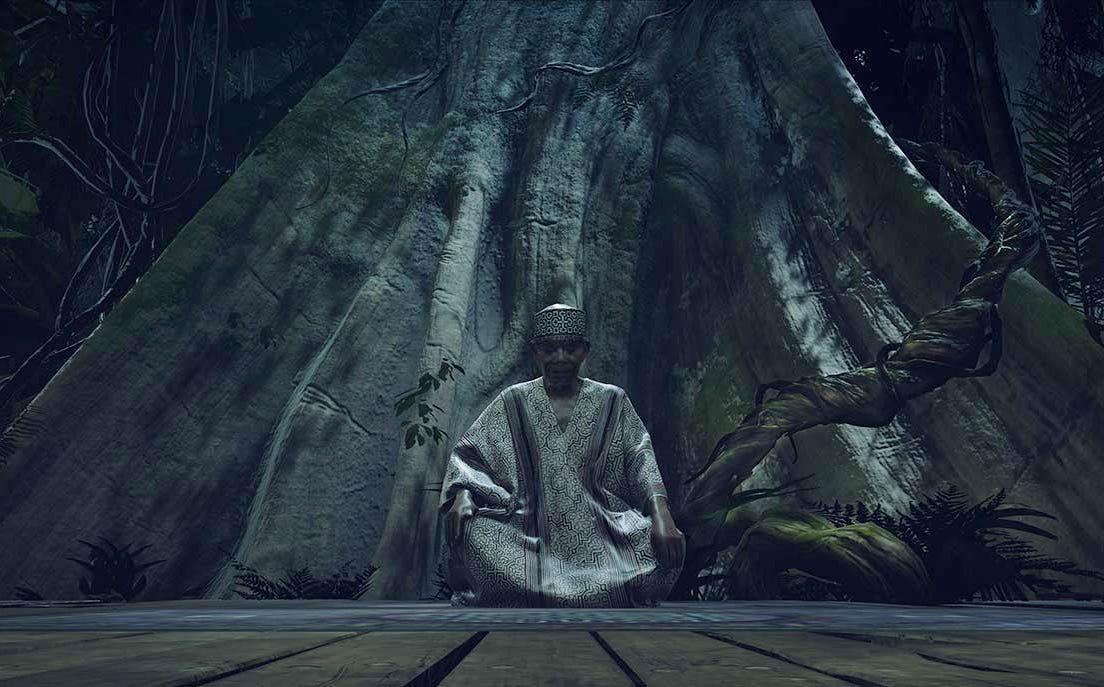
Ayahuasca: Kosmik Journey
A visionary journey through the realms of medicinal plants, led by an indigenous Shipibo healer in the Amazon rainforest.
You begin this experience standing, but are soon instructed by the healer to sit down on the floor. You start your journey in a jungle temple with your spirit guide seated in front of you, but are quickly transported to a very psychedelic world. There’s not much structure or story here, just flying around inside trippy visuals with distant chanting in the background. As with Arden’s Wake, if you truly allow yourself to let go inside this world, it’s pretty easy to convince your brain that this is really happening.
I was warned about motion sickness with this experience, which didn’t affect me, but could easily get to others with more sensitive stomachs. I’d also caution anyone with a fear of snakes against playing this one, or else risk having a very bad trip.
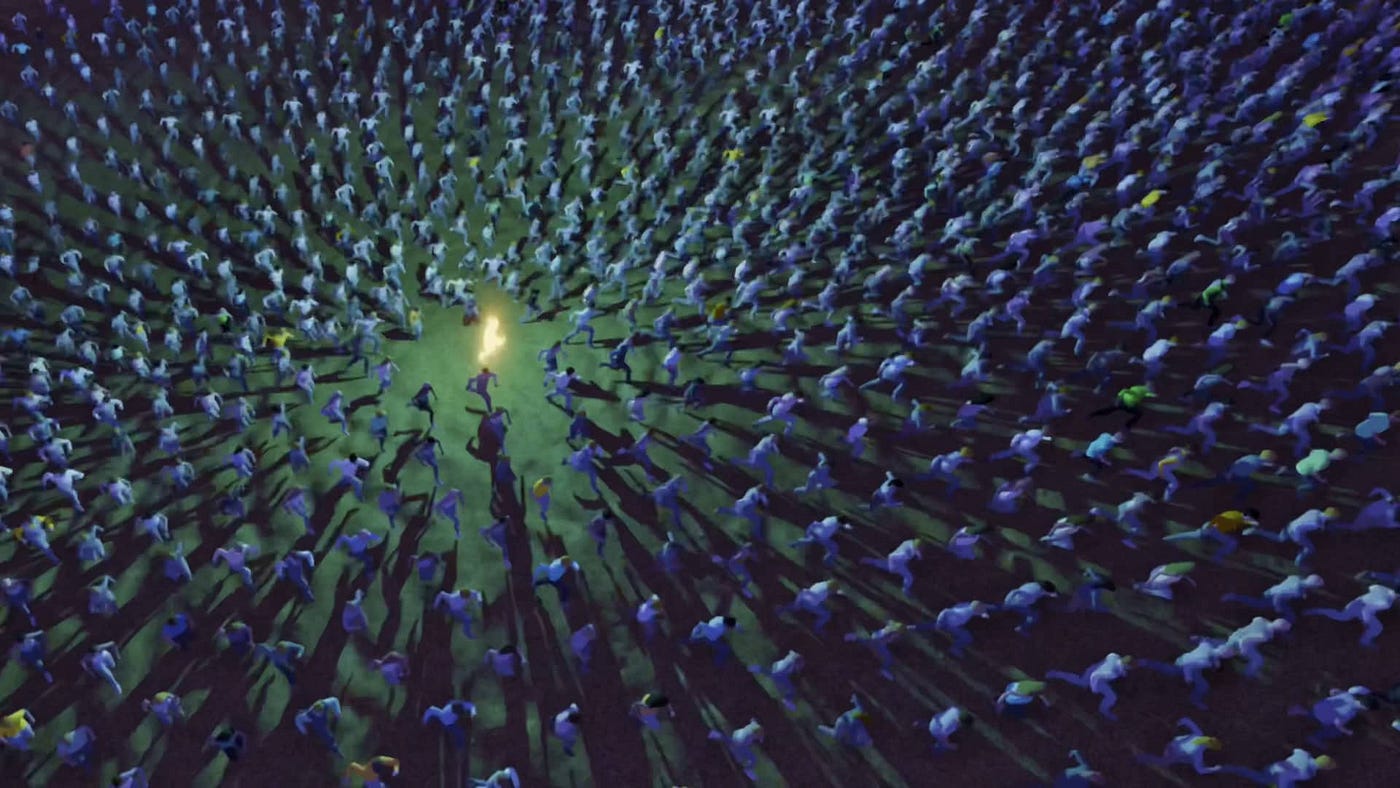
Emergence
Express your primal desire to maintain your individuality amid a crowd in this open-world environment.
This super-short VR experience completely forgoes a narrative and instead thrusts you into a weird space and place. You are floating amid a huge sea of nondescript bodies in a desert-like land. They’re all running in the same direction, practically trampling each other, and you’re going a different way, towards the golden beams of light ahead. When you hit the first beam of light, you change directions and start moving towards the next one, slowing traversing the landscape and occasionally running into the crowd again.
My experience in-world didn’t exactly match up with the metaphorical statement I think the game’s designers are attempting to make here, but that’s okay. Emergence doesn’t take much time or mental energy to play, and it delivers some fun effects in the process, so there’s really nothing to lose by taking it for a spin.
Gloomy Eyes
When the sun got tired of the humans, it decided to hide and never rise again. The darkness has awakened the dead from their graves. Now Zombie kid Gloomy and mortal girl Nena are falling in love, and not even the most powerful man in town can destroy their bond.
This two-chapter story is a passive screening viewed without controllers in hand. It takes an interesting approach, suspending the viewer in front of the characters as the story unfolds, the characters themselves situated upon giant floating chunks of Earth. As they interact and move around the world, the vantage point is often involuntarily rotated for a different viewing angle of the same scene.
The narrator’s voice is charming and I was personally drawn to the darkness of the pretend world, but I couldn’t stop thinking of it as a Tim Burton ripoff; The Nightmare Before Christmas vibes are strong. Unfortunately, the story lacks any kind of depth and comes to a rather abrupt, unsatisfying ending. This experience felt like a 3D pop-up book that never got finished.
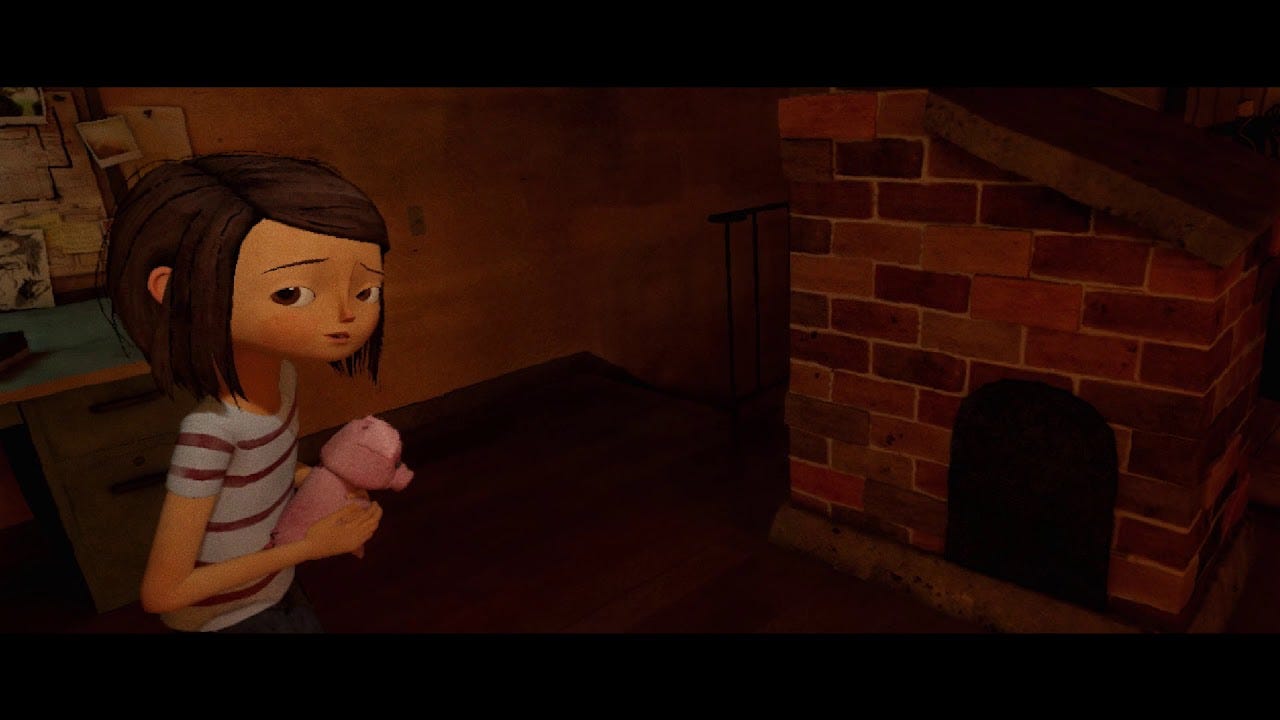
Wolves In The Walls
Not everything is as it seems when 8-year old Lucy’s imagination proves to be a reality. Help her discover what’s hiding inside the walls of her house in this immersive fable.
This story didn’t make much sense to me. Why does Lucy think there are wolves in the walls, and why does nobody else believe her? Is it a metaphor for something else? I was never able to discern the message that the story is trying to communicate.
The interactivity didn’t add any value to the story. Helping Mom stack canned goods in the kitchen isn’t fun or interesting or relevant. Marking spots on the walls where Lucy thinks there are wolves doesn’t result in anything happening. Taking photos with the polaroid I’m handed lights up the attic with light, but alas there’s nothing to be seen, and nothing special develops in the photos I take.
The special effects weren’t striking or transformative. The entire story takes place in Lucy’s home, and we simply float from room to room with her, meeting her family members and listening to them dismiss her concerns about wolves in the walls. “It’s all over when there’s wolves in the walls,” they’d cryptically say before she gets annoyed and fades away into another room.
Wolves In The Walls might be fun for children just starting to dip their toes into the VR pool, but not really for anyone else. There are far better uses of the technology available, with much more satisfying content to digest.
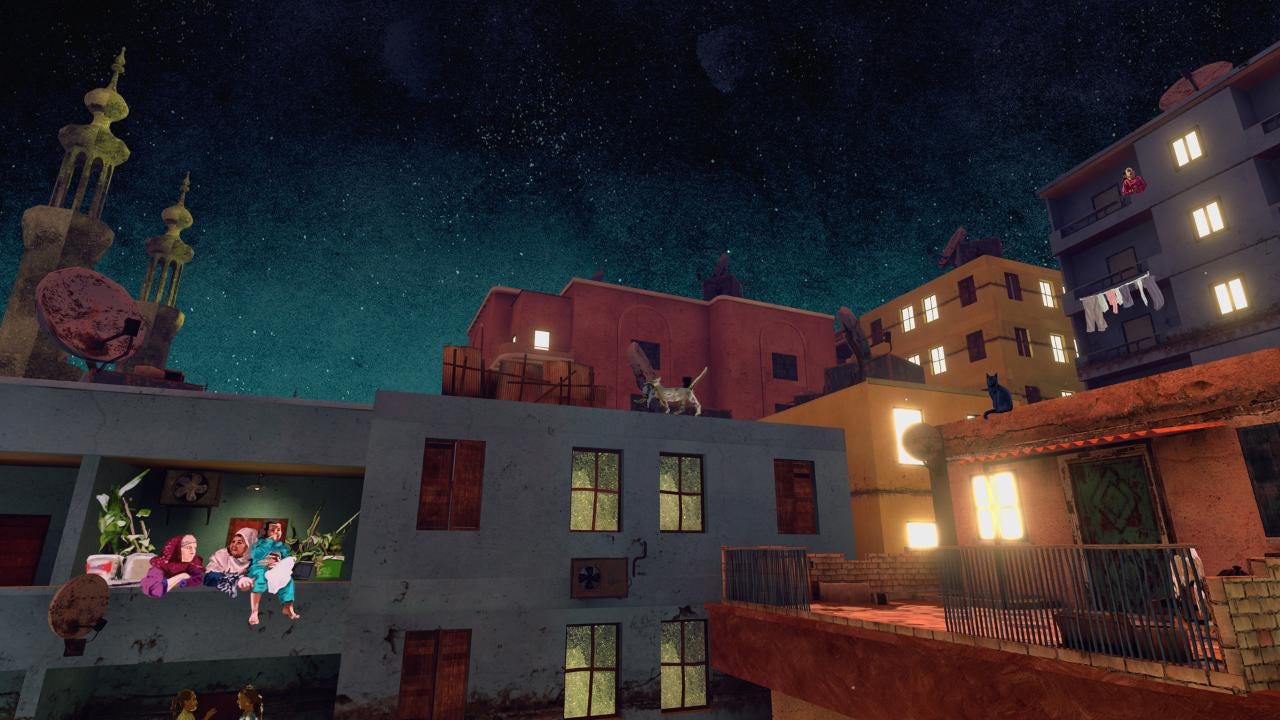
Another Dream
This hybrid animated documentary–VR game brings the gripping and true love story of an Egyptian lesbian couple to life.
This was my least favorite of all the experiences at the festival, primarily because I found the subject matter to be a very bad fit for the medium. VR inherently gamifies its content. Creating an alternate world begs the viewer to go on an adventure in a way that they never could in the real world. So when a VR movie attempts to place me inside someone else’s misery (like in Another Dream and in The Key) I’m immediately turned off.
Further, the tech doesn’t add any value to the story. Everything is animated for anonymity, so the imagery doesn’t assist in helping me understand what the couple was actually seeing and experiencing through their struggles. I don’t feel like I’m actually there; I just feel like I’m watching 2D characters in a simulated environment.
The interactivity in Another Dream is nothing more than outlining Arabic words at the end of each chapter of the couple’s journey. It felt like an after-thought more than a meaningful way to engage with the story. I was annoyed by this, and felt an omission of controllers and engagement altogether would have been a better fit for this experience.
Reflections
I left the Denver Film Fest VR Lounge swimming in questions about the applications of this technology and its place in our society. Is it just for entertainment, or can it have a greater purpose? Is this a toy that can only be used for fun, or can it help us improve our empathy? Does VR content have to employ a gaming mechanism, or can we simply sit and watch? I think it can be all these things and more, but only with appropriate context and on-boarding. A well-done VR film can be a truly transformative experience; we just need to make sure people know and understand where they’re headed before they blast off and unknowingly find themselves somewhere they don’t want to be.
I also concluded that, for me, the best VR experiences are the ones that have familiar real world elements paired with made-up things that can’t possibly exist. Without familiar objects or places from the real world to compare and contrast against, our brains get confused and don’t know how to interpret what we’re observing. But without the fantasy elements to shock, scare and excite us, what’s even the point of making or watching a VR film? When a film has both the comfort of familiarity and the stimulation of novelty — that’s where the fun really begins.
Hats off to the Denver Film Festival and everyone involved with bringing such excellent programming to the city and for making it accessible to everyone. Let’s do it again next year!
The Denver Film Festival has concluded.
NoPro is a labor of love made possible by our generous Patreon backers. Join them today!
In addition to the No Proscenium web site, our podcast, and our newsletters, you can find NoPro on Twitter, Facebook, YouTube, Instagram, in the Facebook community Everything Immersive, and on our Slack forum.
Office facilities provided by Thymele Arts, in Los Angeles, CA.